PREVIOUS
Indian states growth after 1991 Part – 02
Indian states growth after 1991 Part – 02
(இதன் தமிழ் வடிவத்திற்கு இங்கே சொடுக்கவும்)
Economic Performance of Southern States
Karnataka
- Initial Share: Karnataka’s share in India’s GDP was 5.4% in 1960-61, remaining stable until 1990-91.
- Post-Liberalization Growth: Following the liberalization, Karnataka experienced rapid growth:
- 2000-01: GDP share increased to 6.2%.
- 2023-24: Rose further to 8.2%, positioning Karnataka as the third-largest contributor to India’s GDP.
Undivided Andhra Pradesh
- Current Share: As of 2023-24, undivided Andhra Pradesh (including Telangana) accounts for 9.7% of India’s GDP.
- Growth since 1990-91:
- This represents an increase of 2.1 percentage points since 1990-91.
- This growth is largely attributed to the economic performance of Telangana.
- Post-Bifurcation Stability:
- Since the bifurcation, the share of Andhra Pradesh has remained broadly flat.
Tamil Nadu
- Recovery from Decline: Tamil Nadu reversed its pre-1991 decline by increasing its GDP share.
- 1990 - 91: 7.1%
- 2023 - 24: 8.9%, reflecting successful industrial and economic policies.
Kerala
- Initial Growth and Recent Decline: Kerala’s share increased from 3.4% in 1960-61 to a peak of 4.1% in 2000-01.
- Current Share: By 2023-24, it has drifted down to 3.8%, making it the only southern state experiencing a decline in its GDP share.
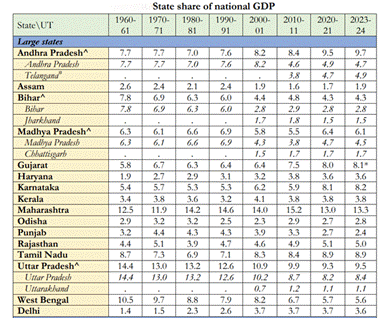
Economic Growth and Relative Per Capita Income in India
Economic Growth of Gujarat and Delhi
Gujarat
- Historical Share: Gujarat's share in India’s GDP was 5.8% in 1960-61, increasing to 6.7% by 1970-71.
- Stagnation and Growth: After remaining relatively flat until 2000-01, Gujarat's economic share began to rise rapidly, reaching 8.1% by 2022-23.
- Context: Notably, Gujarat and Maharashtra were part of the same Bombay state until 1960.
- While Maharashtra has maintained its economic share, Gujarat experienced stagnation before its significant growth in the last two decades.
Delhi
- Impressive Growth: Despite its smaller size, Delhi has seen a remarkable increase in its economic share, rising from 1.4% of India’s GDP in 1960-61 to 3.6% in 2023.
- This makes its economic output comparable to larger states like Haryana and Kerala, highlighting its rapid urban and economic development.
Relative Per Capita Income
- Relative per capita income is a crucial indicator for assessing the economic well-being of individuals within a state compared to the national average.
Per Capita Income in 1960-61
- Delhi: The wealthiest among large states, with a per capita income more than double the national average.
- Maharashtra: Ranked second, with a relative per capita income of 133.7% of the national average.
- West Bengal:
- West Bengal held the third-highest relative per capita income at 127.5%.
- This is higher than states like Gujarat, Karnataka, Tamil Nadu, and Kerala.
- Punjab: Fourth, with a relative per capita income of 119.6%.
- Gujarat: Fifth, with a relative per capita income of 118.3%.
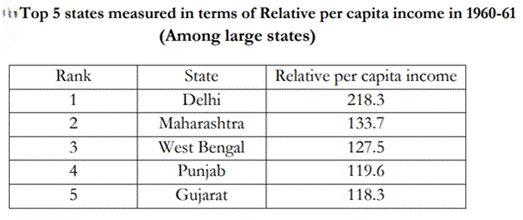
Lowest Relative Per Capita Incomes
- Bihar and Odisha: Both states had the lowest relative per capita incomes, approximately 70-71% of the national average, reflecting significant economic challenges.
Comparative Analysis of Per Capita Income: Maharashtra and Gujarat
- Maharashtra and Gujarat have exhibited strong economic performance over the decades, maintaining per capita incomes above the national average since the 1960s.
- However, their trajectories have diverged significantly, particularly in recent years.
Historical Per Capita Income Performance
1960-61
- Maharashtra: Held a relative per capita income of 133.7% of the national average, positioning it as one of the wealthiest states.
- Gujarat: Lagged behind with a relative per capita income of 118.3%, indicating a substantial economic gap between the two states.
1970s to 2000-01
- Gujarat's Decline: During the 1970s, Gujarat’s relative per capita income declined and remained relatively flat until 2000-01, hovering just above the national average at around 100%. This stagnation highlighted challenges in economic growth during this period.
Post-2000-01 Surge
- Gujarat's Resurgence: Starting from 2000-01, Gujarat experienced a remarkable surge in its relative per capita income, driven by robust economic policies and growth strategies.
- Current Standings as per the latest data:
- Gujarat: Relative per capita income stands at 160.7% of the national average.
- Maharashtra: Relative per capita income at 150.7% of the national average.
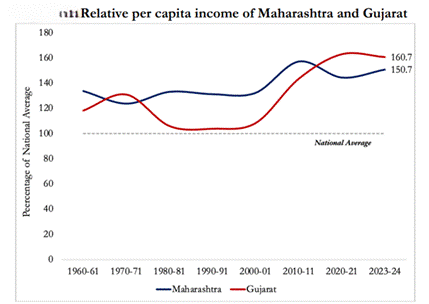
Economic Performance and Per Capita Income: Delhi, West Bengal, and Odisha
- The economic trajectories of Delhi, West Bengal, and Odisha highlight significant contrasts in per capita income and overall economic health, particularly in recent decades.
Per Capita Income Trends
Delhi
- Historical Context: Delhi had the highest per capita income among Indian states in the 1960s.
- Recent Growth: Despite some fluctuations, Delhi's per capita income has steadily increased over the years.
- Current Status: As of 2023-24, Delhi's relative per capita income stands at 250.8% of the national average, meaning the average income in Delhi is 2.5 times that of the average Indian.
- However, it has now been surpassed by Sikkim and Goa.
West Bengal
- Initial Success: West Bengal once ranked third in per capita income in 1960-61, with income 27% above the national average.
- Decline: By 1980-81, the state’s per capita income fell below the national average, indicating significant economic challenges.
- 1990-91 Data: West Bengal’s per capita income was at 82.4% of the national average, showing a further decline after a brief recovery in the following decade.
- Current Standing: As of 2023-24, West Bengal’s relative per capita income is 83.7% of the national average, even lower than in 1960-61, reflecting the ongoing economic struggles of the state.
Odisha
- Historical Context: Traditionally viewed as a laggard state, Odisha has made remarkable progress since the 2000s.
- Significant Improvement: Odisha’s relative per capita income increased from 55.8% in 2000-01 to 88.5% in 2023-24.
- Although still below the national average, this growth represents substantial improvement over two decades.
- Comparison with West Bengal: West Bengal’s per capita income is now lower than that of Odisha.
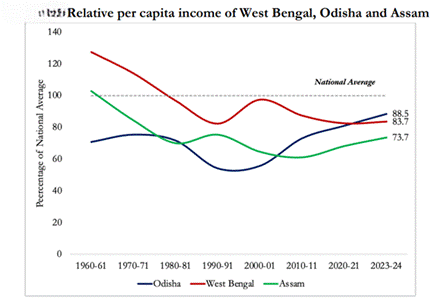
Economic Performance and Per Capita Income: Assam, Punjab, and Haryana
- The economic trajectories of Assam, Punjab, and Haryana reflect varying outcomes influenced by historical policies and regional developments, particularly in terms of per capita income.
Per Capita Income Trends
Assam
- 1960-61 Context: In 1960-61, Assam's per capita income was slightly above the national average, at 103%.
- Decline: Over the following decades, Assam's relative per capita income steadily declined, reaching a low of 61.2% by 2010-11.
- Recent Recovery: Since then, Assam has experienced a resurgence, with its relative per capita income rising to 73.7% in 2023-24, indicating a positive turnaround in economic performance.
Punjab
- Initial Growth: Following the Green Revolution in the 1960s, Punjab saw a rapid increase in per capita income, rising from 119.6% of the national average in 1960-61 to 169% in 1970-71.
- Divergence from Haryana: However, Punjab's economic trajectory began to diverge significantly from Haryana’s after this period.
- By 1980-81, Punjab's relative per capita income had declined to 146.1% and remained relatively stable until 2000-01.
- Recent Decline: Post-2001, Punjab’s per capita income began to decrease again, reaching only 106.7% of the national average in 2023-24, lower than its level in 1960-61.
- This stagnation reflects a lack of significant economic push or growth in GSDP beyond the initial gains from the Green Revolution.
Haryana
- Strong Performance: Like Punjab, Haryana also benefited from the Green Revolution, with a relative per capita income of 106.9% in 1960-61, rising to 138.5% by 1970-71.
- Post-Liberalization Growth: After 1990-91, Haryana's relative per capita income began to rise rapidly, reflecting successful economic policies and development strategies.
- Current Standing: By 2023-24, Haryana's relative per capita income reached 176.8%, positioning it as the fourth-highest among major states, following Delhi, Telangana, and Karnataka.
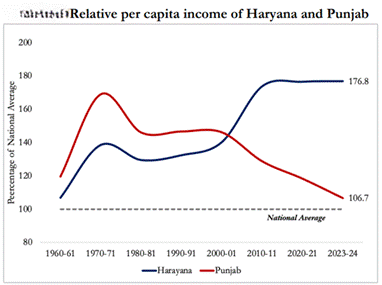
Key Economic Developments and Trends in Southern India
- Southern states have shown varied economic performances.
- Karnataka has risen from 5.4% of India's GDP in 1960-61 to 8.2% in 2023-24, thriving post-liberalization.
- Undivided Andhra Pradesh stands at 9.7%, benefiting from Telangana's growth.
- Tamil Nadu recovered to 8.9%, while Kerala declined to 3.8%.
- These dynamics reflect distinct regional strengths and challenges in the South's economic landscape.
-------------------------------------


